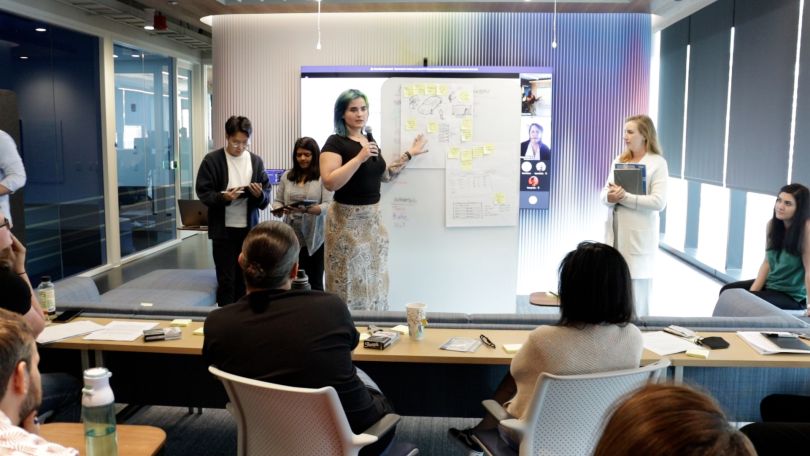Complexity is a common theme in the automotive repair world today. Among the contributors is the proliferation of new technologies, from ultrasonic sensors in our bumpers to long-range radar behind the windshield to support adaptive cruise control. And, not surprisingly, with growing complexity comes increased costs, especially costs associated with repairs after a collision occurs.
“Vehicles today have a million lines of code running through them,” explained Vice President of Product Management Mark Fincher. “And when a car has been in an accident, those systems can be impacted. It’s our job to help repair facilities manage these new challenges.”
“Vehicles today have a million lines of code running through them. Our job is to help repair facilities manage these new challenges.”
CCC Intelligent Solutions is a leading SaaS platform powering AI-enabled workflows for insurers, collision repair facilities, automakers, parts suppliers and more.
Within CCC’s platform is a sleek and simple diagnostics solution that helps collision repairers administrate the complexities of vehicle diagnostics.
In an era of increasingly complex, connected and computerized vehicles, creating a simplified diagnostic tool add-on to support documenting insurance claims was a tantalizing engineering challenge for CCC teams. In addition to simplifying the diagnostic process, the solution helps technicians work with insurance carriers to deliver more consistent estimates and repair procedures for improved repair quality.
This is where design thinking proved its worth.
A formalized five-step methodology popularized in the ’90s, design thinking helps teams maintain focus on the user experience through a practical framework reliant on rigorous research and ideation.
The Five Stages of the Design Thinking Method
- Empathize: Research your users’ needs.
- Define: State your users’ needs and problems.
- Ideate: Challenge assumptions and create ideas.
- Prototype: Start to create solutions.
- Test: Try your solutions out.
“Through its various methods, design thinking gives us a shared understanding faster and provides a framework to consume uncertainty, allowing us to de-risk the bets we are putting into the marketplace — all before a single line of code is written,” said CCC Director of Product Design Charles Plath.
To build its diagnostic solution with confidence, CCC’s design team began by conducting thorough user research to understand the pain points and needs of their target audience: collision repairers. Here is what that process looked like.

Learning the Language
Collision repair shops are often the ones helping rattled customers through post-accident repairs. In order to empathize with the customer — the first step of design thinking — CCC’s Principle of Design Strategy and Innovation Randy Simms and his team spent four weeks visiting collision repair shops in four different states.
“We noticed certain patterns in shops and were able to identify different user archetypes. As we started to think about solutions, we weren’t thinking in terms of a universal user, but how each archetype would react to a solution,” said Simms. “It gave us a whole new perspective, empathy and understanding of the different types of roles and personas and how they act within the shop and drive different behaviors,” said Simms.
“It gave us a whole new perspective, empathy and understanding of the different types of roles and personas and how they act within the shop and drive different behaviors.”
“It’s a lot like language acquisition,” added Plath. “Say you want to learn French — you’d start with a book. Then you get to France, and you find out quickly that the book didn’t prepare you for any of it.”
“For example, the term ‘vehicle mapping’ is something we learned about before going into the field,” said Simms. “Once we got into the shops, we saw how they draw on the vehicle using erasable pens to map the damage. The goal of the research was to bring back learnings like this and more to CCC. It wasn’t just our team wanting to have an understanding but sharing it with the wider organization so everybody could inhabit those shoes. As we think about solutions, we want to understand who we are building them for. Design thinking helps strike better alignment between teams and allows you to make better decisions.”
Once Simms’ research concluded, his team brought their observations back to CCC, converted them into meaningful insights and quickly came up with a design that would solve the right problems.
But there was one issue: it was too complex.

Striving for Simplicity
“The biggest challenge for this specific product was simplicity,” said Fincher. “There’s a quote from Mark Twain: ‘I would have written you a shorter letter but I didn't have the time.’”
“We came up with complex designs that covered all of the use cases quickly,” he continued. “But it would have taken days of training for our users to understand how to configure the application. It wasn’t obvious at first, so we spent the next three to four months iterating, and it wasn’t until we had a massive on-site meeting with the full design and development teams that it finally came together.”
That meeting of the minds helped fuel the fire of product design, ensuring that Simms’ new understanding of CCC’s shop users was felt deeply across the teams. “Developing a common language led to that acceleration,” added Simms.
As Plath tells it, getting buy-in for this level of immersive research and ideation is uncommon in many organizations, though the benefits of this process speak for themselves. “‘We are not the users’ is something we find ourselves saying repeatedly.”
Fincher likens complex auto diagnostics to a trip to the doctor’s office. On the surface, there might be something as simple as a rash or runny nose, but every doctor is still going to check a patient’s heart, lungs, eyes and ears to get to the root of the problem. No matter how simple the surface repair seems — a crack in the windshield or ding in the bumper — it’s important for auto technicians to look under the hood for more insidious problems to help vehicle owners get back on the road safely. And it’s particularly important when you consider what most of these owners have just been through — the harrowing ordeal of a collision.
“At the core of it, design helps with simplicity. When you’re dealing with insurance and repair facilities as a consumer, it’s a different language. You’re being thrown into an alien landscape. Good design in technology masks its complexity and restores its humanity,” said Simms.
What’s more, design thinking helps product teams see past the razzle dazzle and stay focused on the user experience. “There are lots of sleek, newfangled technologies that might look impressive, but don’t serve a purpose,” Simms said. “I think it’s easy to get enamored by technology, but sometimes it isn’t really helpful for the ones who actually use it.”
Building a Culture of Innovation
CCC holds three to four hackathons each year. “The goal is to bring a diverse cross-functional team together to create a shared understanding to solve complex problems,” said Plath. But, according to Plath, it would be short-sighted to assume that the goal of the hackathon is just to create a new product, feature or solution. “We’re shaping the topography of the company in a way that makes it easier for employees to collaborate. We’re creating an environment where we can get better outcomes, faster. Getting people excited about hackathons and design thinking spreads these ideas, methods and the spirit of collaboration throughout the company.”
Confident design
With complexity comes risk. Design thinking helps create more certainty — a particularly important quality in the high-stakes environment of auto repair.
“Architect Frank Lloyd Wright said it best,” said Plath. “‘You can use an eraser on the drafting table or a sledgehammer on the construction site.’” It’s a quote that sits on Plath’s desk, and one that he cites regularly around the office. “I quote it often. It’s just asking the question: Is this a gamble we’re willing to take? Yes? Then how do we go about de-risking it?”
“Architect Frank Lloyd Wright said it best: ‘You can use an eraser on the drafting table or a sledgehammer on the construction site.’”
CCC is positioning itself ahead for the future of insurance claims and collision repair with these smart strategies.
“Complex industries like insurance, finance or healthcare have traditionally been slow-moving, and they thought their complexity was like a moat around all of these antiquated systems — protecting them from competitors. Now, a fast-moving startup with a few subject matter experts can swoop in with something modern and sleek, and all of a sudden it’s stealing a slice of their value stream,” Plath said. “Our customers are expecting CCC to help them by operating like a startup as well, moving quickly and designing modern experiences, and we believe that implementing design thinking, research and these types of methods helps us do just that.”
Fincher agrees. These design methodologies get to the heart of the user experience and elicit the true feelings of its customers.
“There are thousands of problems we can solve,” said Fincher. “We have tens of thousands of pieces of feedback, and most of them are good ideas. Design thinking helps us understand the underlying problem so we can prioritize and figure out where to focus.”








